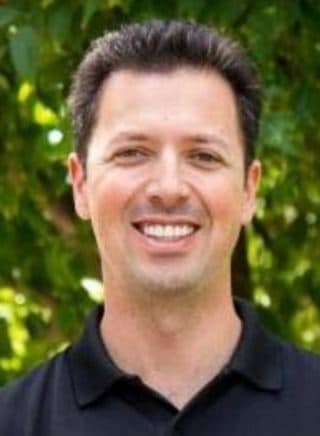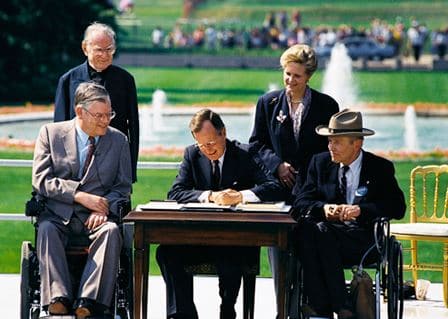Editor’s Note: Today’s post continues the discussion by Abigail Farmer and Bruno Sarda on the evolution of hearing aid technology.
The Americans with Disabilities Act (ADA) makes it illegal to discriminate against disabled individuals.1 Under the Act, disabled means that an individual is “substantially impaired with regard to a major life activity, has a record of such an impairment, or is regarded as having such an impairment.” Hearing loss can qualify as a substantial impairment under the ADA.
Title IV of the Act specifically addresses telephone and television access for individuals with hearing and speech disabilities.2 It requires that common carriers such as telephone companies establish both interstate and intrastate telephone relay services, which allow callers who use telecommunications devices for the deaf3 to communicate via a third party operator. The relay service consists of an operator with a TTY who translates the TTY and voice messages; the caller types in a message, which the operatorreads to the call’s recipient.4 The Act also provides for closed captioning of federally funded public services announcements in certain limited situations.5
Education of Deaf and Hard of Hearing Individuals
Traditionally, the two main schools of thought in deaf education were oralism and manualism. Oralism was based on the notion of integrating deaf students to the largest extent possible into mainstream society: teaching them to read lips and articulate instead of using sign language.6 Manualism focused on teaching via sign language.7
Interestingly, Alexander Graham Bell was one of the biggest opponents of sign language; he viewed sign language as both a foreign language and a leading cause of intermarriage between deaf people, which he feared would lead to the creation of a “deaf race.”8 Although this position is decried today, Bell’s ideas had a lasting impact on deaf education.9
The advent of the hearing aid created a shift in deaf education. In 1864, two years after the Morrill Act was passed, Congress authorized and President Lincoln signed into law the charter for Gallaudet University, the first university for the deaf.10 Almost immediately, the university pushed back against oralism as a primary method of instruction, noting that “when deafness is congenital . . . no amount of teaching or effort can produce more than a very imperfect and limited power of articulation.”11

Alexander Graham Bell
The significance of the oralism/manualism debate shifted in the 1930s, however. With the advent of “strong, portable, and wearable hearing aids”, a new classification of student was created: hard of hearing students.12 While the debate over oralism and manualism still exists for educating the truly deaf, hearing aids lightened the intensity of the debate where students have some residual hearing.13
These distinctions still matter. Current education policy places Deaf children and children with hearing loss in the same classroom.14 However, Deaf children learn visually, while hard of hearing children tend to have developed at least some auditory-verbal skills.15 Combining the two groups deprives the hard of hearing children of an opportunity to further develop their auditory skills.16 Hearing aids can enable these children to assimilate into a classroom of hearing students.
Hearing Aid Access
Social stigma may impact an individual’s willingness to use a hearing aid, but the biggest barrier to accessing hearing aids is their cost. Each individual hearing aid can cost anywhere from $800 to $4000, with the average cost for a pair being about $4800.17 Price is of course a function of the hearing aid’s features, including style and the supporting technology, but most hearing aids still must be professionally fitted,18 which accounts for much of the cost of hearing aids.19
Given hearing aids’ high cost and importance, one would expect them to be covered by most insurance. Although select groups of veterans can receive hearing aids through the VA,20 only 19 states require that health insurance cover hearing aids—and of those, only three require coverage for adults.21
 Individuals can create a health savings account “into which they deposit money and then withdraw it tax-free” for certain approved medical expenses, including hearing aids and hearing aid batteries, but private health insurance plans rarely cover hearing aids.22 Medicare does not either.23
Individuals can create a health savings account “into which they deposit money and then withdraw it tax-free” for certain approved medical expenses, including hearing aids and hearing aid batteries, but private health insurance plans rarely cover hearing aids.22 Medicare does not either.23
To be sure, in July 2015, the United States House of Representatives introduced proposed legislation, the “Seniors Have Eyes, Ears, and Teeth Act,” which would expand Medicare coverage to include hearing aids.24
While passing this Act would indeed make hearing aids more accessible, this is far from the first time such an expansion has been proposed.25 For the time being, at least, seniors seeking hearing aids cannot depend on Medicare or private insurance.
Beyond price and insurance coverage (or lack thereof), distribution methods also restrict access to hearing aids. From a regulatory perspective, hearing aids are can be classified as class I or class II medical devices, depending on the kind of hearing aid.26 Class II devices “require premarket review and clearance by FDA before marketing, while Class I have lighter restrictions.27
Regardless of classification, all hearing aids must comply with patient and professional labeling requirements, both on the hearing aid device and the packaging and package inserts.28 More importantly, FDA regulations restrict hearing aid distribution: “a prospective hearing aid user must provide to the hearing aid dispenser a written statement from a licensed physician that the prospective user has been medically evaluated and is a candidate for a hearing aid.”29
In essence, the FDA’s restricts hearing aid distribution to encourage prospective hearing aid users to seek medical evaluation and receive treatment for treatable forms of hearing loss.30 However, per FDA regulations, prospective users over the age of eighteen can waive the requirement for a written statement from a physician; state attempts to restrict mail order sales of hearing aids without a physician examination have been struck down as preempted by the Medical Devices Amendment to Federal Drug and Cosmetic Act.31 As such, states cannot place stricter regulations on hearing aid sales than what federal regulations provide.32
*Stay tuned for Part 10. Images courtesy wikipedia, historytoday, helpwithaging
References:
- See generally 42 U.S.C.A. §§ 1201–12213 (West 2009).
- Id.
- These devices are known as TDDs by the hearing community and as TTYs by the devices’ users. TTY, NC Hearing Loss, (last visited Mar. 15, 2016).
- Id.
- Id.
- R.A.R. Edwards, Words Made Flesh: Nineteenth Century Deaf Education and the Growth of Deaf Culture 2 (2012).
- Id. at 3.
- Signing, Alexander Graham Bell and the NAD, PBS, (last visited Apr. 25, 2016).
- See, e.g., A Deaf Variety of the Human Race, My Gallaudet University, (last visited Apr. 25, 2016); Oralism and the Irony of Alexander Graham Bell, Redeafined Mag. (Feb. 29, 2012).
- History of Gallaudet University, Gallaudet University, (last visited Apr. 24, 2016).
- E.M. Gallaudet, Ninth Annual Report of the Columbia Institution for the Deaf and Dumb 592 (1866)
- M. Reis, Student Life at the Indiana School for the Deaf During the Depression
- Years, in Deaf History Unveiled: Interpretations from the New Scholarship 201 (J. Vickrey Van Cleve, ed., 1993).
- Id.
- Id.
- Id.
- Id.
- Paul Dybala, Hearing Aid Prices, Healthy Hearing (Oct. 16, 2015).
- Id.; Wayne Staab, Hearing Aid Distribution III, Hearing Health & Tech. Matters (June 13, 2013).
- David Gauvey Herbert, Bluetooth Earpieces Do Battle with the $3000 Hearing Aid, Bloomberg (Mar. 5, 2015, 4:32 PM).
- U.S. Dep’t Veterans Affairs, Federal Benefits for Veterans, Dependents and Survivors Chapter 1 Health Care Benefits: Prosthetic and Sensory Aids, (last visited Apr. 25, 2016).
- Lisa Packer, Why Aren’t Hearing Aids Covered by Insurance?, Healthy Hearing (Jul. 7, 2015).
- Paul Dybala, Finding Financial Assistance for Hearing Aids, Healthy Hearing (Mar. 16, 2016); Am. Speech-Language-Hearing Ass’n, Health Savings Accounts and Speech-Language Pathology Coverage 1–2.
- 42. U.S.C.A. § 1395 (West).
- H.R. 3308, 114th Cong. (2015).
- See, e.g., H.R. 5853, 113th Cong. (2014); H.R 504, 111th Cong. (2009)
- 21 C.F.R. §§ 874.3300, 874.3305 (West 2000).
- ¶ 350,739 Regulatory Requirements for Hearing Aid Devices and Personal Sound Amplification Food Drug Cosm. L. Rep. P 350739
- Id.
- Id. Prospective users over the age of eighteen can waive this requirement.
- Id.
- Miss. Board Examiners for Hearing Instrument Specialists v. Hearing Help Express, Inc., 447 F.3d 1033, 1034–35 (8th Cir. 2006).
- Id.

Abigail Farmer graduated summa cum laude with B.A.s in French and Spanish from Texas A&M University. Before starting law school, she interned with the U.S. Commercial Service in Paris, France. Abigail served as Executive Note and Comment Editor for the Arizona State Law Journal from 2014–2015 and as the Hong Kong team editor for the Wilhem C. Vis International Commercial Arbitration Moot from 2015–2016. She also co-authored an article on bitcoins and estate planning, which won the Mary Moers Wenig Student Writing Competition and was published in the ACTEC Law Journal; she and her co-author presented the article at the Arizona State Bar Convention. Abigail is graduating summa cum laude with a J.D. from the Sandra Day O’Connor College of Law and with an M.B.A. from the W.P. Carey School of Business. After graduation, Abigail will join Shell’s legal department in Houston, Texas
 Bruno Sarda is a leading practitioner in the field of corporate sustainability at Dell, where he’s worked since 2005. In his role as Director of Social Responsibility, he leads the company’s strategy on social aspects of sustainability, including human rights and labor practices, working with internal and external stakeholders. He also manages Dell’s groundbreaking partnership with Phoenix-based TGen (Translational Genomics Research Institute) to accelerate adoption of precision medicine in addressing childhood cancer. In addition, Sarda is an adjunct faculty member and Senior Sustainability Scholar at Arizona State University, where he teaches and helped design and launch the Executive Master’s for Sustainability Leadership working with the Rob and Melani Walton Sustainability Solutions Initiatives at ASU.
Bruno Sarda is a leading practitioner in the field of corporate sustainability at Dell, where he’s worked since 2005. In his role as Director of Social Responsibility, he leads the company’s strategy on social aspects of sustainability, including human rights and labor practices, working with internal and external stakeholders. He also manages Dell’s groundbreaking partnership with Phoenix-based TGen (Translational Genomics Research Institute) to accelerate adoption of precision medicine in addressing childhood cancer. In addition, Sarda is an adjunct faculty member and Senior Sustainability Scholar at Arizona State University, where he teaches and helped design and launch the Executive Master’s for Sustainability Leadership working with the Rob and Melani Walton Sustainability Solutions Initiatives at ASU.






